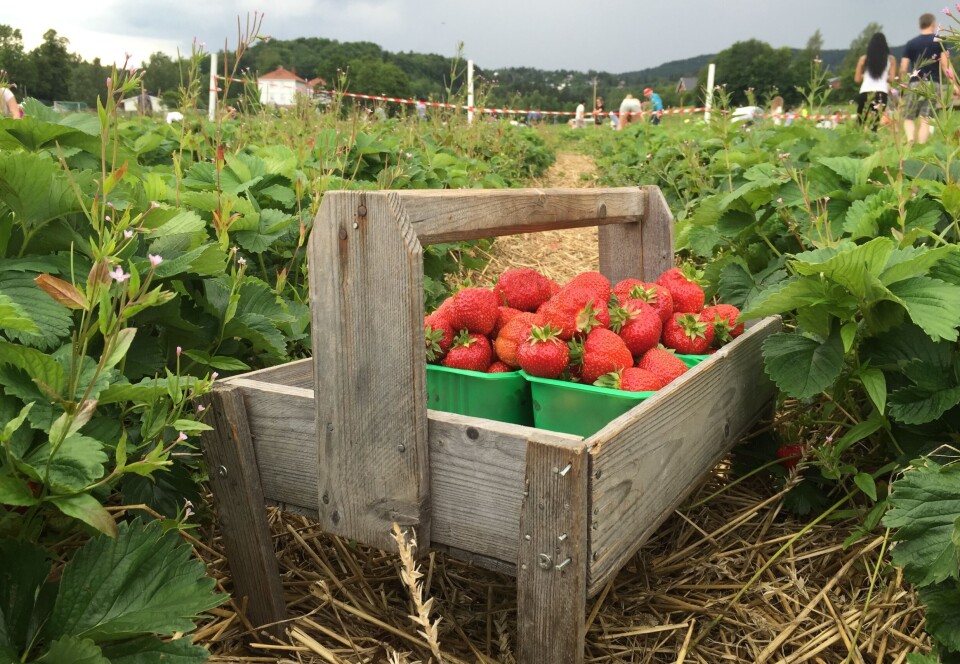THIS CONTENT IS BROUGHT TO YOU BY the Norwegian University of Life Sciences (NMBU) - read more
Who’s picking your strawberries this summer?
Migrant workers are the backbone of Norway’s berry farms, but new research shows they face long hours, low pay, and poor living conditions – despite being essential to the country’s food supply.

As in other high-income countries, Norway's agricultural industries rely heavily on migrant workers. Of the 88,600 migrant workers on Nordic farms, around 18,000 work in Norway.
This workforce is crucial for berry production – particularly raspberries and strawberries.
Raspberry and strawberry picking is particularly labour-intensive. The fruits are easily damaged and require careful handling, so harvesting is done manually. Machines are unable to do the job without bruising the fruit.
Also, the berries do not all ripen at the same time. Workers have to selectively pick only the ripe ones and leave the rest to further mature. This process requires checking each berry individually, which takes a lot of time.

In Norway, berry farming is seasonal due to the colder climate. Harvesting happens in the summer months, mainly for the domestic market. Farms often grow large areas of berries to meet demand, so a large workforce is needed to pick the fruit in the limited harvesting window. Since berries ripen over several weeks, workers have to harvest the same plant multiple times during the season.
All these factors make raspberry and strawberry picking a demanding job that relies heavily on manual labour over a relatively short period. This is where migrant workers come in.
Mostly Eastern European workers
Norwegian agriculture is mostly made up of small family-run farms. These farms are supported by state subsidies and import regulations. In the past, they relied on local labour, but since the 1990s, they have used more foreign workers as fewer locals are available.
Most migrant workers on Norwegian berry farms come from the European Economic Area (EEA), predominantly Eastern Europe – mainly Poland and Lithuania. A smaller portion – around 3,000 per year – come from outside the EU/EEA, including South-East Asia and Ukraine.
What’s the problem?
Norway is often seen as a country with good working conditions, but new research shows that migrant workers have a different experience. Greta Juskaite, a PhD student at the Norwegian University of Life Sciences (NMBU), explored the challenges these workers face and how these problems reflect larger issues.
“While Norway offers legal frameworks for minimum wage and labour rights, actual implementation of these protections often falls short, leaving migrant workers vulnerable,” she explains.
As a Lithuanian herself, she made sure to account for potential bias in her research.
Her research found several key issues:
- Visa and immigration costs: Non-EU/EEA workers face visa costs and restrictions on how long they can stay. This places them at a disadvantage compared to their EU/EEA counterparts, who do not face these restrictions.
- Low wages: Migrant workers often receive lower wages compared to other trades, despite the labour-intensive nature of berry farming.
- Long working hours: The short window for berry-picking results in extended working hours for migrant workers.
- Poor living conditions: Many migrant workers live in substandard housing due to ineffective enforcement of labour laws.
- Lack of recognition: Despite their essential role in agriculture, migrant workers are rarely acknowledged in media narratives, which usually highlight the success of the berry season while ignoring the workers’ challenges.
- Ineffective regulation enforcement: Norway has good labour laws, but these regulations are not always properly enforced, which means migrant workers are not adequately protected.
- Global labour fragmentation: Changes in global politics and economics have made labour markets more fragmented, deepening inequalities and worsening working conditions for migrant workers.
Why don’t farmers just offer ‘pick-your-own’?
While ‘pick-your-own’ setups can lower labour costs and offer an engaging experience for consumers, there are several reasons why Norway’s berry farms still rely on workers.
The growing season is short and unpredictable, making it hard to synchronise with public demand. The berries are delicate and require careful handling, and casual pickers might inadvertently damage the crop. This can affect the quality of the fruit and hurt profits.
It is also difficult to ensure people only pick ripe berries. On top of that, hosting visitors requires building extra facilities and taking on more insurance costs.
Even though more people are interested in local, sustainable food, the demand may not be sufficient enough to support an entire farm this way. So, while ‘pick-your-own’ can bring in some extra profits, it cannot replace traditional harvesting. That means caring for migrant workers is still essential.
Labour regulation for sustainable food production
Juskaite found that migrant workers play a key role in keeping Norway's agriculture going, yet they are often overlooked and under-appreciated. She believes that better labour policies and public recognition of their important role are needed.
She calls for a re-evaluation of Norway's agricultural practices and policies. She urges stakeholders to recognise and support migrant workers more effectively.
“By focusing on the lived realities and contributions of our migrant workers, Norway can move towards a more equitable food system. This approach not only benefits the workers but also strengthens the agricultural sector and enhances sustainability of food production, necessary to ensure the provision of food security in the long term,” she says.
———
Greta Juskaite will defend her PhD thesis Harvesting fields of inequity: Dealings of power in and through food and agrarian systems on June 26, 2025 at the Norwegian University of Life Sciences.
More content from NMBU:
-
We're eating more cashew nuts – and the consequences are serious
-
Do young people with immigrant parents have better health?
-
Can coffee grounds and eggshells be turned into fuel?
-
Rising housing costs fuel inequality in Norway
-
Researchers warn: Climate change in African mountains has a greater impact than previously thought
-
Algae turns wastewater into resources





































